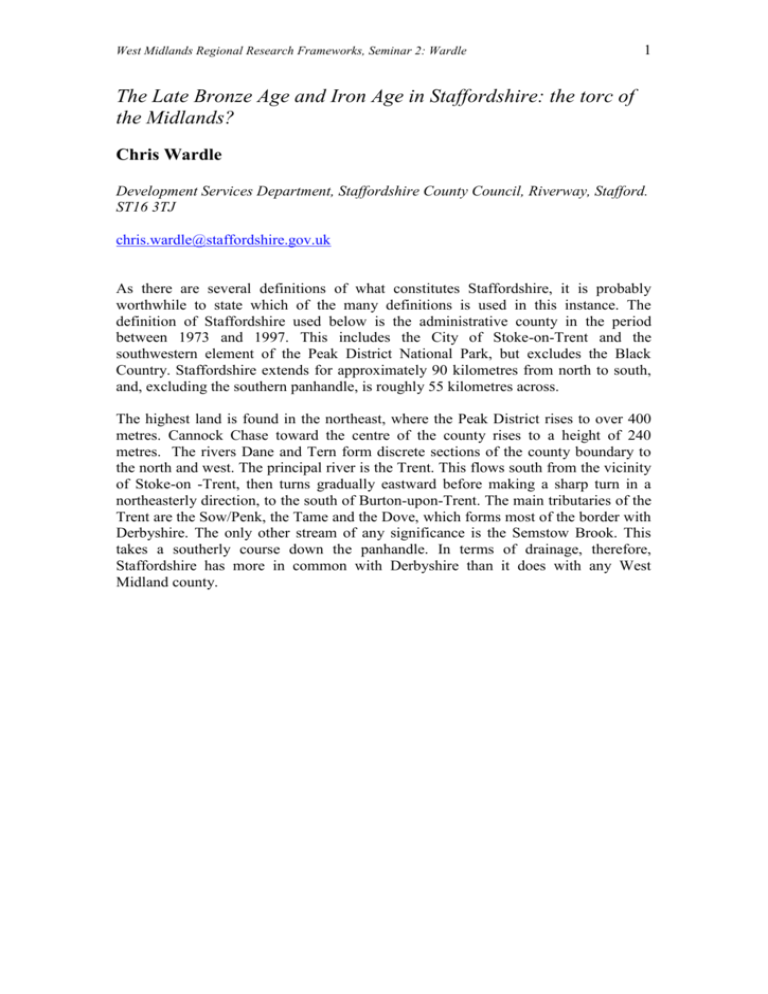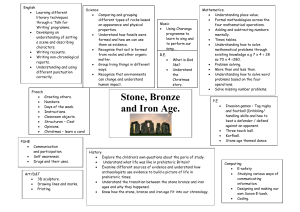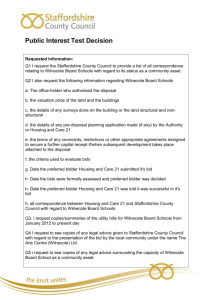Chris Wardle - University of Birmingham
advertisement

West Midlands Regional Research Frameworks, Seminar 2: Wardle 1 The Late Bronze Age and Iron Age in Staffordshire: the torc of the Midlands? Chris Wardle Development Services Department, Staffordshire County Council, Riverway, Stafford. ST16 3TJ chris.wardle@staffordshire.gov.uk As there are several definitions of what constitutes Staffordshire, it is probably worthwhile to state which of the many definitions is used in this instance. The definition of Staffordshire used below is the administrative county in the period between 1973 and 1997. This includes the City of Stoke-on-Trent and the southwestern element of the Peak District National Park, but excludes the Black Country. Staffordshire extends for approximately 90 kilometres from north to south, and, excluding the southern panhandle, is roughly 55 kilometres across. The highest land is found in the northeast, where the Peak District rises to over 400 metres. Cannock Chase toward the centre of the county rises to a height of 240 metres. The rivers Dane and Tern form discrete sections of the county boundary to the north and west. The principal river is the Trent. This flows south from the vicinity of Stoke-on -Trent, then turns gradually eastward before making a sharp turn in a northeasterly direction, to the south of Burton-upon-Trent. The main tributaries of the Trent are the Sow/Penk, the Tame and the Dove, which forms most of the border with Derbyshire. The only other stream of any significance is the Semstow Brook. This takes a southerly course down the panhandle. In terms of drainage, therefore, Staffordshire has more in common with Derbyshire than it does with any West Midland county. West Midlands Regional Research Frameworks, Seminar 2: Wardle 2 The county is especially fortunate in terms of the number of monuments that predate the late Bronze Age.1 Well over 250 round barrows are recorded in the county. Many of these, including most of those in the limestone area of the Peak District, survive as substantial earthworks. In addition, a large number of Neolithic and Bronze Age monuments; causewayed enclosures, henges and ring ditches have been observed in the form of cropmarks on the river terraces in the region of the confluence of the Trent and Tame. Whilst many of the ring ditches may not be evidence for plougheddown round barrows, a number of excavations in the area suggest that the majority are the remains of burial mounds. 1 Unless stated otherwise, all the information supplied in this paper comes from Staffordshire Sites and Monuments Record. West Midlands Regional Research Frameworks, Seminar 2: Wardle 3 Neolithic & Bronze Age Ritual Monuments Key Purple: Round Barrows Blue: Cropmarks of Causewayed Enclosures, Henges and Ring Ditches There are a number of indicators for the continuity of activities after the main era of the construction of ritual monuments in the county. One such comes from Bartonunder-Needwood, in the Trent valley to the south of Burton. In 1996, during the excavation of a pair of ring ditches, a flat cremation cemetery was found to lie just beyond the remains of a ploughed-out round barrow. A group of 21 cremations were excavated, along with the remains of five cinerary urns. The urns were of the DeverelRimbury type and are believed to date from the middle Bronze Age.2 To date, 21 burnt mounds have been identified in Staffordshire. All of these are in the central part of the county. The majority lie in the vicinity of Cannock Chase, and many of these are to be found in a single cluster beside the Moreton Brook. Of the 21, ten still survive as earthworks. Only one burnt mound has been excavated. This is the most northerly example, at Milwich, where the farmer noticed the mound in spite of it being buried under a metre of colluvium. This was due to it being exposed in the bank of a stream. As the mound was considered to be in danger from erosion, the site was excavated. C14 dating suggested that the mound was originally used in the early Bronze Age, but that it seems to have been reused until the late Bronze Age.3 The chance discovery of this example raises the question as to how many other instances there might be in the county of burnt mounds buried under later deposits. A. Martin and C.S.M. Allen, ‘Two prehistoric ring ditches and an associated Bronze Age cremation cemetery at Tucklesholme Farm, Barton-under-Needwoood, Staffordshire.’ Transactions of the Staffordshire Archaeological & Historical Society, xxxix, (2001) 1-15. 3 C.M. Welch, ‘A Bronze Age ‘burnt mound’ at Milwich.’ Transactions of the Staffordshire Archaeological & Historical Society, xxxvi, (1997) 1-15. 2 West Midlands Regional Research Frameworks, Seminar 2: Wardle 4 Burnt Mounds Although it is now recognized that many examples have their origins in the Bronze Age, hillforts have long been regarded as the archetypal monument of the Iron Age. So it is appropriate that they should be the first monuments we should examine when looking for evidence for the late Bronze Age and Iron Age activity. There may be as many as eleven hillforts in the county, but not all of these are confirmed examples. Of those monuments which are most definitely hillforts, one is multivallate in form, three are univallate, and two are promontory forts. The remaining definite hillfort is so badly damaged that we cannot be certain what form the defences took. In addition there are two possible hillforts beside the River Dove, and a rather more questionable site in the northeast of the county.4 4 The multivallate hillfort is Castle Ring (PRN 25, at SK04431282) the largest hillfort in the County, Bury Bank (PRN 22, at SJ88203590) Berth Hill (PRN 23, at SJ78793904) and Berry Ring (PRN 24, at SJ88752120) are univallate, Kinver Camp (PRN 195, at S083558326) and Bishop’s Wood (PRN SJ74483355) the example at Bunbury (PRN 64, at SK07104312) was severely damaged when the site was landscaped for the Earl of Shrewsbury’s estate at Alton Towers, and has probably been further damaged by the process of turning the estate into a theme park. It has been suggested that the earthworks which lie outside the later defences at Tutbury Castle (PRN 40, at SK20922919) could be those of a hillfort, and a earthwork a few kilometres to the west at Forest Bank (PRN 727) could be those of a hillfort. It has also been suggested that Harecastle Clump (PRN 30042) is also a hillfort, but the reason for this belief is unclear. West Midlands Regional Research Frameworks, Seminar 2: Wardle 5 Hillforts Key Green: Definite hillforts. Blue: Possible and doubtful hillforts. Unfortunately, there is not sufficient information to allow us to make an adequate analysis of the distribution of these hillforts. All we can say is that they seem to be fairly evenly distributed save for a slight bias in favour of the western side of the county. There is also an apparent absence of hillforts in the Peak District.5 Our knowledge of the hillforts in Staffordshire is hampered by the very limited nature of the fieldwork. We only know of two hillfort excavations. One is a recent evaluation and subsequent watching brief at Alton Towers. This revealed no significant archaeological deposits.6 The other is a 19th-century excavation at Castle Ring. All we know of this dig is that William Molyneux, a local historian, carried it out, and that the footings of a building, believed to be a mediaeval hunting lodge, were exposed.7 The rectangular footings of this stone structure are still visible, but the excavation report was never published and the records are now lost. As a result we do not know if any evidence for prehistoric activity was encountered. The only other recorded fieldwork is the hillfort survey carried out by the RCHM(E). Although this survey has provided valuable insights as to the sequence of construction and renewal of the 5 It is worth noting that, in spite of the dearth of hillforts in the Staffordshire part of the Peak, a number of examples are to be found elsewhere in the Peak District. pers. comm. A. Myers. 6 Anon, Proposed new ride at Alton Towers: Desk based archaeological assessment. (unpublished report by Oxford Archaeological Unit, held in SMR, 1998); C. Bell, Proposed new ride at Alton Towers: Archaeological evaluation report. (unpublished report by Oxford Archaeological Unit, held in SMR, 1998); J. Dalton, Proposed new ride at Alton Towers: Archaeological watching brief assessment. (unpublished report by Oxford Archaeological Unit, held in SMR, 1999) 7 B.B. Simms, ‘Notes.’ Transactions of the North Staffordshire Field Club, lxvi, (1932) 192. West Midlands Regional Research Frameworks, Seminar 2: Wardle 6 defences, it does not provide a chronology, nor can it tell us anything about was going on in the interiors.8 We need to look at other sites to obtain a fuller understanding of what was going on in the late Bronze Age and Iron Age. The most obvious thing to look for is evidence of settlement or field systems. In a county with a reasonable amount of upland the first place to look would be in these uplands where prehistoric sites might still be seen as earthworks. Unfortunately, relatively few earthworks have been demonstrated to be the remains of settlement and field systems that are late Bronze Age, Iron Age or Roman in date, and those that are all lie in the vicinity of the Manifold Valley.9 There is, however, some reason for optimism in this regard. A recent survey has identified a number of other earthworks in the Peak District as potentially being Roman in date, and a number of these sites might, upon examination, turn out to be late Bronze Age or Iron Age in date.10 Furthermore, there are extensive earthworks in the form of enclosures, extant field boundaries, banks and lynchets, in the limestone areas of the Peak District, especially in the vicinity of the Manifold Valley.11 It is extremely likely that were more of these earthworks to be examined, a considerable proportion would be found to be Bronze Age or Iron Age in date. 8 Anon, Royal Commission Hillfort Survey Report. (unpublished report by Royal Commission on the Historic Monuments of England, held in SMR, 1996) 9 F. Cleverdon, ‘Survey and Excavation in the Manifold Valley.’ Staffordshire Archaeological Studies, v, (1995) 10 G.A. Makepeace, ‘Romano-British rural settlement in the Peak.’ Derbyshire Archaeological Journal, cxii, (1998) 95-138. 11 R.A. Meeson, The Manifold Valley Survey. (unpublished report by Staffordshire County Council, held in SMR, 1984) West Midlands Regional Research Frameworks, Seminar 2: Wardle 7 Earthworks of late Bronze Age, Iron Age or Romano-British settlements and Field Systems. Fortunately, there is another way in which prehistoric settlements and field systems manifest themselves, that is as cropmarks. Staffordshire is especially favoured by having an abundance of cropmarks, many of which are traces of prehistoric settlement and field systems. Although some of these features have been recorded on other aerial photographs, most cropmarks have been recorded on aerial photographs taken specifically for archaeological purposes. We owe a great deal to these surveyors, most of whom are amateurs. In Staffordshire the greatest debt is owed to the efforts of Jim Pickering. Before turning to look at how cropmarks can add to our knowledge of the late Bronze Age and Iron Age in Staffordshire, it is worth considering the factors affecting the identification of cropmarks from the air. Perhaps the most significant factor is that flying is expensive. Another major consideration is that cropmarks are best seen under certain conditions. At best, these ideal conditions only occur on a few days a year when crop growth and ripening passes through certain stages. In many years the ideal conditions do not occur at all. In years when these conditions do occur, it is difficult to predict if and when they will occur. It should also be understood that those who survey for cropmarks only have limited access to aircraft. Often they only have a share in aircraft or else they only have access to a plane owned by a flying club. So when the correct conditions occur these archaeological surveyors have to drop whatever else they are doing, arrange to have access to a plane and take to the skies at short notice. The expense and the limited window in time have had a profound effect on how people have set about looking for cropmarks in the county. The first phase has been an initial survey, looking for areas where the geology favours the formation of West Midlands Regional Research Frameworks, Seminar 2: Wardle 8 cropmarks. Subsequently, the surveyors have tended to visit and re-visit those areas where the ground conditions favour cropmark formation. Even within these areas there are certain areas where there are strict controls on civil aviators. The normal practise, therefore, has been to pay particular attention to complexes of cropmarks, in order to identify additional detail. The only areas to receive similar attention are those that are in the vicinity of important archaeological monuments, especially Roman sites. As a result, it has been a long time since fliers looking for cropmarks have visited most of Staffordshire.12 Cropmarks of late Bronze Age, Iron Age or Romano-British settlements and field systems. The vast majority of these cropmark sites are to be found on the terraces of the Rivers Trent and Tame, close to the confluence of these two rivers. Smaller clusters are also to be found near to some of the county’s principal Roman sites. Relatively few of these features have been subjected to excavation. It is likely that a proportion of the features shown on the map will be due to geological and agricultural features and not to archaeology. Similarly not all of the archaeological cropmarks will be evidence of late Bronze Age and Iron Age activity. Many cropmarks will be Roman in date and some even later in origin. Given the limited nature of the resources available to archaeologists, it is inevitable that the vast majority of the features revealed as cropmarks will never be the subject of an excavation. Indeed many cropmarks in Staffordshire have been destroyed either 12 Some detail as the methods techniques employed in archaeological aerial survey can be found in D.R. Wilson. Air photo interpretation for archaeologist. (London, 1982) and D.N. Riley Aerial photography and archaeology. (London, 1987). However, most of what I know of the techniques used by aerial surveying has been learnt through conversations with Jim Pickering, Fred Hartley and the late Derek Riley. West Midlands Regional Research Frameworks, Seminar 2: Wardle 9 with very minimal salvage recording or else with no archaeological fieldwork at all.13 The only evidence we will ever have for many of these cropmark sites are the aerial photographs themselves and any plots that might be produced from them. Fortunately, certain inferences may be drawn directly from the aerial photographs. Plot from aerial photographs Kings Bromley, Staffs. In the centre of this plot, we see a number of ring ditches, which almost certainly mark the site of a barrow cemetery. We can also see a field system, the boundaries of which are shown by a series of pit alignments. The fact that the pit alignments respect the ring ditches cropmarks indicates two things. The field system was set out some time after the presumed barrows had been constructed, and the presumed barrows must have been substantial earthworks when the fields were established. The above example also serves to illustrate that there are limits to the number of reliable inferences that can be drawn from the cropmarks without recourse to excavation. Without excavation we cannot be absolutely certain that the ring ditches were barrows. Similarly, without excavation there cannot be any certainty about the date of the field system. Excavation of the late Bronze Age and Iron Age cropmarks in Staffordshire has had varied success. On one hand there have been cases where no trace of the cropmark could be found,14 or where the features were so truncated as to yield little evidence.15 On the other hand some of the field investigations of cropmarks have yielded, or are yielding, a considerable amount of evidence. One example of a site that has added a vast amount to our knowledge of the period is Stuart Losco-Bradley’s excavation at Catholme. Although this site is probably best known for Anglo-Saxon settlement evidence, a large prehistoric settlement was identified utilising the site of an earlier round barrow. The site was first occupied during the late Bronze Age and the site 13 An example of an important site that has been destroyed with only minimal fieldwork is the cluster of hut circles at Stretton, north of Burton. These features were destroyed in the 1960s when the area was developed. The hut circles were subject to a very limited salvage excavation that was reported in H. Wheeler, ‘Notes’ Report of Archaeological Excavations. (1969) 46. The excavators found two pits, one containing Iron Age pottery and the other Romano-British pottery. Even they were forced to admit that this level of recording did not do the site justice. 14 E.G Hughes, King’s Bromley, Staffordshire: An archaeological evaluation alongside the A513. (unpublished report by Birmingham University Archaeological Field Unit, held in SMR, 1990) 15 E.G. Hughes, An archaeological evaluation at Newbold Gravel Pit, Barton under Needwood, Staffordshire, 1991-92. (unpublished report by Birmingham University Archaeological Field Unit, held in SMR, 1992) West Midlands Regional Research Frameworks, Seminar 2: Wardle 10 continued in use during the Iron Age. However, it seem that at some point before the Roman invasion the settlement site shifted to a site beyond the excavated area. 16 The gravel quarry at Whitemoor Haye may prove to be a site of similar interest. Here an ongoing programme of excavation has identified a system of Bronze Age drove-ways on the site, part of which was occupied by a number of barrows. Some time in the Iron Age or else during the Roman period the drove-ways were replaced by a field system.17 In spite of the abundant evidence of late Bronze Age and Iron Age activity in the south east of the county there are still significant gaps in our understanding of this period. We only have very little idea of what was going on beyond the southeastern corner of the county. The only source of information currently available that might fill this void is the information provided by find-spots. These are the places where the general public - gardeners digging their back yards, farmers ploughing their fields, and people out walking or, as is increasingly the case, using metal detectors - come across artefacts. Before we turn to looking at distribution maps of these finds it is probably useful to consider the shortcomings of any plot of the distribution of reported find-spots. The most serious difficulties relate to the way in which find of this nature come to be reported. The vast majority of such discoveries probably never get reported to an archaeologist. Even where they are reported the accuracy of the location is often uncertain and the level of precision at which the location is reported is often inadequate. To add to these problems it is very difficult, using simple dot distribution maps, to differentiate between locations from which individual finds were recovered and those from which a number of finds (e.g. coin hoards) have been found. In spite of these shortcomings, the study of the distribution of reported find-spots has the potential to contribute to our understanding of the past. Before we can gain any understanding of the past through an examination of distribution maps, it is necessary to understand the factors that distort the apparent distribution. In the case of find-spots we should expect two principal biases in the data. The first of these is that we should anticipate a greater density of reported findspots in the vicinity of urban areas. This is because there will be a far greater density of gardeners digging their gardens and allotments in the suburbs than there will be farmers ploughing their fields in rural areas. Furthermore, far more people go for walks in the urban fringe than go for walks anywhere else, and the heaths, moors and grassland which draw walkers beyond the urban fringe tend not to provide the conditions for chance finds of artefacts. The second bias we should anticipate is a greater level of recovery of finds from the vicinity of important monuments. These areas, especially the vicinities of well-known Roman sites, attract people using metal detectors. Even if the metal detectorists are looking for material from other periods, they are likely to find at least some material from the late Bronze Age and Iron Age. S. Losco-Bradley & G. Kinsey, ‘Catholme an Anglo-Saxon settlement on the Trent gravels in Staffordshire.’ Nottingham Studies in Archaeology. iii (2002). 17 Pers. comm. Gary Coates (2002). 16 West Midlands Regional Research Frameworks, Seminar 2: Wardle 11 Late Bronze Age and Iron Age find-spots. It is possible to identify the more obvious biases when studying the above distribution maps. There are clearly areas of greater densities of find-spots in the vicinity of two of the major urban centres, the conurbation of Stoke on Trent and Newcastle and Burtonupon-Trent, and a less obvious cluster near Tamworth.18 There are also clusters near the barrows of the Peak District and three of the better known Roman sites, Wall and Penkridge.19 Setting aside the obvious biases, it is immediately clear that find-spots are much more widespread than either hillforts or the evidence for settlements and field systems. I would also suggest that there is a greater density of find-spots in the arable areas, which tend to be restricted to the valleys of the Trent, Tame, Sow and Penk. It is, however, difficult to provide an analysis as to why this might be the case. To some extent this probably reflects a genuine tendency on the behalf of the people of this period to settle on the land that is easier to cultivate using modern techniques. It probably also reflects the fact that farmers are more likely to find artefacts on ploughed land than on pasture, and are more likely to allow people using metal detectors onto ploughed land than elsewhere.20 18 The absence of a similar cluster of find-spots in the vicinities of the other sizable towns, Stafford and Cannock, is difficult to explain, but may be linked to the proximity to Cannock Chase. The Chase attracts many walkers, but it is covered by forest, bracken, heather and grass. Chance finds tend not to be made in these conditions. 19 Of the other main Roman sites much of one, Chesterton/Holditch, lies under factories and it is possible that many of the detectorists who work close to the other two, Rocester and Greensforge, either tend not to report their finds, or else report them to museums well beyond the County (e.g. Derby) 20 Anecdotal evidence indicates that many arable farmers are quite willing to allow detectorists on their land in the period between ploughing and their seeds sprouting, on the condition that any profits will be West Midlands Regional Research Frameworks, Seminar 2: Wardle 12 It is also clear that we do not know enough about the processes of find deposition and recovery, to be able to make a detailed analysis of find-spots. The contrast between Iron Age find-spots. the relative abundance of late Bronze Age find-spots and the dearth of Iron Age material serves to illustrate this point. The most likely explanation is that the Bronze Age artefacts recovered from find-spots are invariably of gold, bronze or flint. Ground conditions mean that most other materials, such as wood and leather, do not survive in the soil, and those materials that do survive, chiefly pottery fired at low temperatures, are easily overlooked. In the Iron Age, bronze and flint ceased to be used for the manufacture of tools. The material that replaced it, iron, either does not survive, or else tends to be overlooked.21 This does not mean that the Iron Age cultures of Staffordshire were marked by relative poverty. The gold and bronze torcs found in a number of sites in the county give the lie to this idea.22 At the end of the Iron Age, for the first time, the native peoples in what is now Staffordshire came into contact with a literate society. It might have been hoped that Greek and Roman authors provided a clear picture of the country that the legions invaded in the first century AD. Unfortunately, this is not the case. Classical historians do provide a sketchy account of the conquest of southern England,23 but shared. On the other hand, many farmers with livestock will not let people with detectors on their land for fear that their animals will hurt themselves in the remains of the pits excavated by the detectorists. 21 Anecdotal evidence indicates that metal detectorists often tune their machines so they can avoid spending time digging for iron objects, many of which will be horse shoes or items of modern agricultural equipment. 22 The gold examples from the Needwood Forest, and Glascote, near Tamworth, and the recent discovery at Alrewas are as fine as any in other parts of the West Midlands. 23 Even here the relevant section of one writer’s history, Tacitus’ Annuals, is missing. So we are heavily reliant on Cassius Dio. West Midlands Regional Research Frameworks, Seminar 2: Wardle 13 they tell us nothing directly of the occupation of the West Midlands. Nevertheless, through a combination of reading accounts of later campaigns and inscriptions found beyond the county, modern historians believe there were two, or possibly three tribal groups living in the area that is now Staffordshire. These were the Cornovii, whose heartland was in Shropshire, the Coritani,whose main focus was in Leicestershire, and the Brigantes, who inhabited northern England.24 Tribes at time of the Roman Conquest. This is an interesting strand of evidence, as it might indicate to what extent these tribal confederations were transforming themselves into proto-states. We are, however, immediately confronted by two difficulties. We cannot be certain how accurate this information is, nor do we know to what extent the situation reported by classical authors was the result of the crisis brought about by the Roman invasion. There are, therefore, three main strands of evidence for the late Bronze Age and Iron Age in Staffordshire. These are evidence from the hillforts, the earthworks and cropmarks of settlement and field systems, and find-spots. None of these strands by itself will ever provide a complete picture of the period. However, by studying all three strands and furthering our information base we may begin to complete our picture of the period. In the case of the hillforts, fieldwork is urgently required. This should be undertaken with a view to establishing a reliable chronology and in order to ascertain what role, if any, the hillforts played in the hierarchy of settlement. The evidence provided by the earthworks and the cropmarks provides more detail than any other form. Unfortunately, this evidence is very dependent upon local circumstances and is only present in discrete parts of the county. One method of 24 Based on the details in S.S. Frere, Britannia a History of Roman Britain (2nd edition, London, 1979) West Midlands Regional Research Frameworks, Seminar 2: Wardle 14 improving our information base is through embarking on a programme of broadening our methods of survey, especially aerial photographic surveying. We also need to create and develop techniques that will enable us to gain some understanding of those cropmarks that have not been excavated. Only a minority of these cropmarks will ever be excavated and it is important that we understand not only the individual hut circle and enclosure, but also as far as possible the entire landscape.25 Yet even if we do have the results of field research in the county’s hillforts, extend our survey for cropmarks and have tools at our disposal that enable us to analyse unexcavated cropmarks, there will still be huge gaps in our knowledge. Only by recovering artefacts can we hope to plug some of these gaps. There are two ways in which we might hope to overcome the biases in the Staffordshire data: The first of these is to establish a programme of systematic fieldwalking using a sampling strategy. This might also help to fill some of the gaps in our knowledge about some of the other periods. Largely as a result of lack of resources, Staffordshire has lagged behind some of the other West Midlands counties in this regard. The second is in the manner in which we liase with metal detectorists. Along with many archaeologists, I regard detectorists with suspicion, and believe that they cause a great deal of damage. There are, however, a lot of them, and they are out there gathering data. Moreover, there is no prospect that metal detectors will be banned or that people will need a licence to use them. So we might as well make use of the information they can provide. The present situation, under the Portable Antiquities Scheme, is that one Portable Antiquities Officer is tasked with liasing with all the metal detectorists, museums and sites and monuments records across the entire region. In spite of her best efforts, it is an impossible task. Under the extended scheme there will be additional Portable Antiquities Officers, but still not enough. The Scheme will still be a temporary arrangement with no consideration of what will be put in its place when it ends. The arrangements for liaison between Portable Antiquities Officers and sites and monuments records will still be inadequate, and there are insufficient resources to educate the metal detecting community. I would like to see the Scheme made permanent and these shortcomings addressed. • 25 When this issue was raised during the seminar, Professor Bradley said that the RCHM(E) project aimed at dating features on typological grounds foundered because it did not take regional variations into account. I do not doubt the truth of what he said, but would still argue that it would be very useful to develop this type of technique. We should explore the possibility of developing regional typologies. In the case of Staffordshire, where the majority of known cropmarks lie in the valleys of the Trent and its tributaries, it might not be appropriate to see the cropmarks in a West Midlands context. It might be more useful to look at them in the context of the Trent basin.









